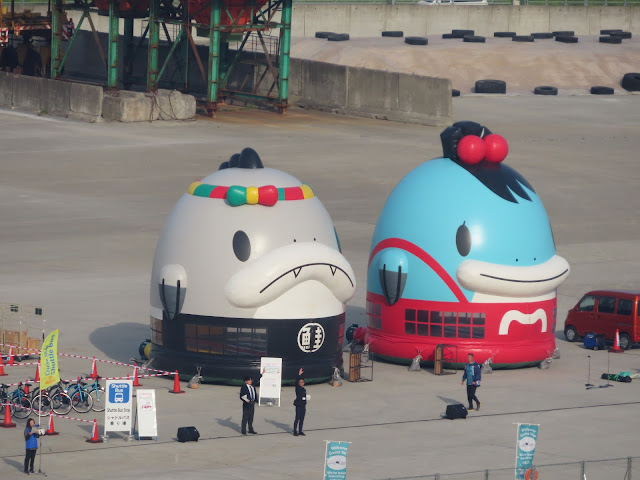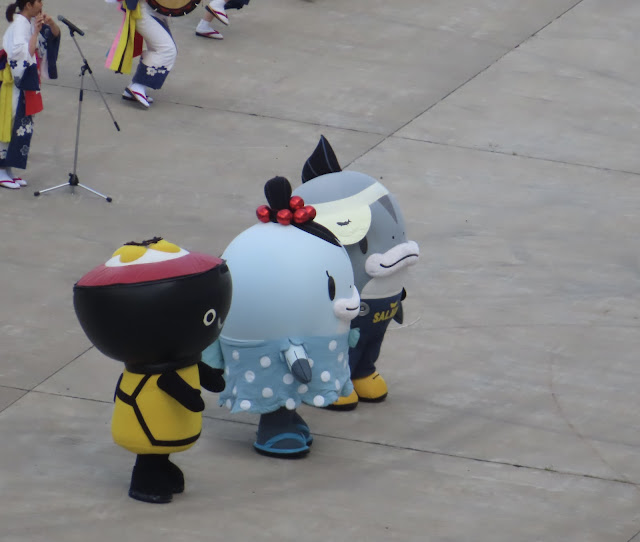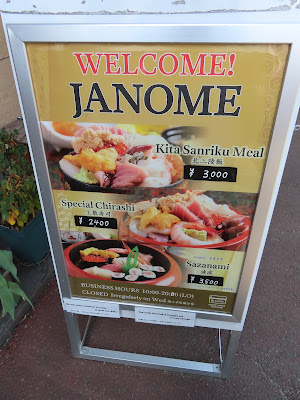Monday, April 29, 2024
Shōwa Day
Today, Shōwa Day, is one of the public holidays of Golden Week. Shōwa Day honors the birthday of Hirohito (Emperor Shōwa) who reigned from 1926 to 1989. Shō means “shining” or “bright,” and wa means “peace.” The day is traditionally celebrated by visiting shrines, the National Shōwa Memorial Museum, or the Imperial Mausoleum. Many see the day as a day of reflection on the complex events that took place during the Shōwa period, including World War II and the rebuilding of Japan afterward.
Yesterday was a day at sea, and nothing much happened. I am going to write about all the days at sea together in a single post later on.
Miyako
 Today we arrived at the small town of Miyako, in Iwate Prefecture. (There is more than one place called Miyako in Japan.) Today’s Miyako is a town of about 50,000, located on a beautiful bay and surrounded by forests and mountains.
Today we arrived at the small town of Miyako, in Iwate Prefecture. (There is more than one place called Miyako in Japan.) Today’s Miyako is a town of about 50,000, located on a beautiful bay and surrounded by forests and mountains.
 |
The parking lot filled up as visitors arrived at the port. Note the extensive seawall that has been built
(since 2011, I assume) to protect against tsunamis. |
The tsunami caused by the 2011 Tohoku Earthquake devastated Miyako. All but 30-60 of the town’s fishing fleet of 960 boats were destroyed. According to Wikipedia,
Some of the most iconic footage of the tsunami, repeatedly broadcast worldwide, was shot in Miyako. It shows a dark black wave cresting and overflowing a flood wall and tossing cars, followed by a fishing ship capsizing as it hit the submerged flood wall and then crushed as it was forced beneath a bridge.
Cruise ships stop in Miyako infrequently, and I wasn’t sure why Royal Princess was planning to stop there. There are only a few local attractions, most notably Jōdogahama, a National Place of Scenic Beauty.
The town gave us such a warm and enthusiastic welcome, that the greeting alone was reason enough to stop there, IMHO.
Perhaps it was because we were there on a holiday, but throughout the day, hundreds - maybe thousands - of people came to the dock to see the ship. Families brought their children. High school students showed up to practice their English, to give directions, to translate, and to demonstrate origami. Cute little food trucks showed up, and they did a brisk business. So did the makers, weavers, and craftspeople. Drummers and dancers and giant fish came to entertain us. It was just lovely!
Please watch this 10-second video (that took me over 30 minutes to upload, thanks to the ship’s slow internet). It shows local drummers and dancers performing for our ship. (I hope you will be able to play it.)
More photos of the goings-on at the dock: |
I bought this bag at one of the craft booths.
It is made from scraps of old sails. |
 |
| The food trucks have arrived! |
We took the shuttle into town for a look around. It really wasn’t much. It was a blue-collar town, with no souvenir shops or luxury shops. There was a shop that sold fabric and sewing machines, but you could tell that it was there to support people who made their own clothing or maybe repaired a sail or two.
There were a handful of restaurants. Most were closed for the holiday or because it was a Monday. I was amused by the name of this restaurant:My sewing machine is a Janome, made in Japan. “Janome” means “snake’s eye” because the round bobbin, a recent innovation when the company was founded, looked like a snake’s eye.
We ended up going to a restaurant called Fuku, for ramen. The broth was thinner than broth we have had in other places, but the meat was extremely tasty.
 |
It looks kind of like a bar, but it’s just a tiny restaurant with four tables, and two things
on the menu - ramen or wonton. |
After lunch we went back to the dock and poked around the booths for a while, then we went back onboard to watch the rest of the entertainment.
My name in Japanese, written by one of the cultural ambassadors of Miyako:
I loved the Tiger Dance. Tigers are not native to Japan, so the dance must have come over from China or India 670 years ago. Tigers were believed to have the ability to tame the wind, and that was important for fire protection, so the legend must have resonated with the people who lived here in this windy part of Honshu.
Today’s fabric is recycled polyester scraps from old sails.
 Today we arrived at the small town of Miyako, in Iwate Prefecture. (There is more than one place called Miyako in Japan.) Today’s Miyako is a town of about 50,000, located on a beautiful bay and surrounded by forests and mountains.
Today we arrived at the small town of Miyako, in Iwate Prefecture. (There is more than one place called Miyako in Japan.) Today’s Miyako is a town of about 50,000, located on a beautiful bay and surrounded by forests and mountains. 

























Another interesting and fascinating posting…thank you….Shirley Radder
ReplyDeleteThat looks like so much fun!
ReplyDeleteGreat greeting! Thanks for the video. All the dancers! Love the tigers. Becky.
ReplyDelete